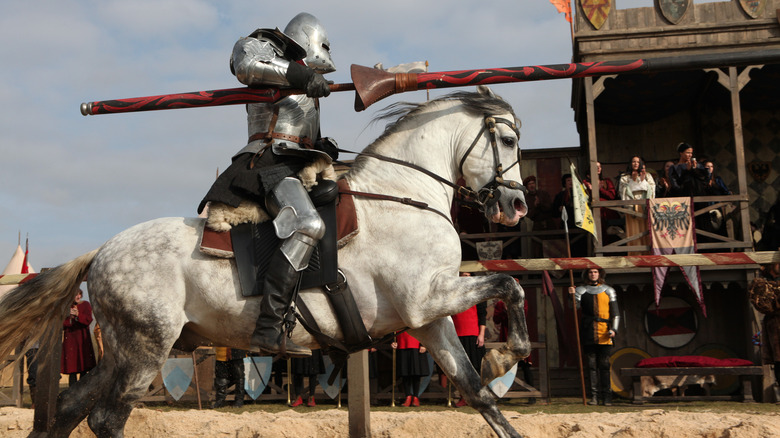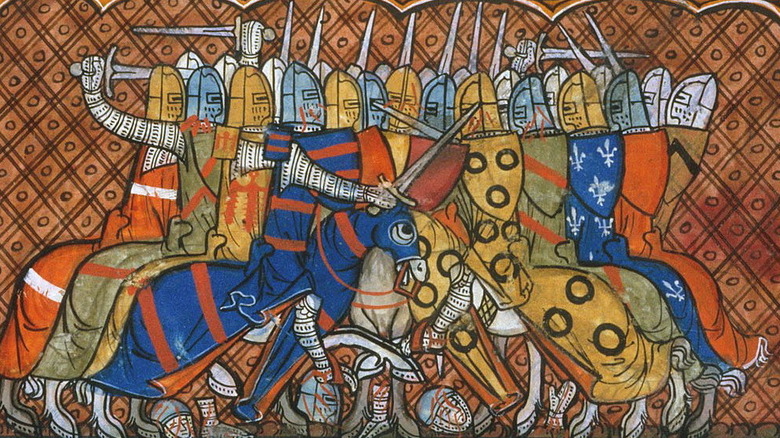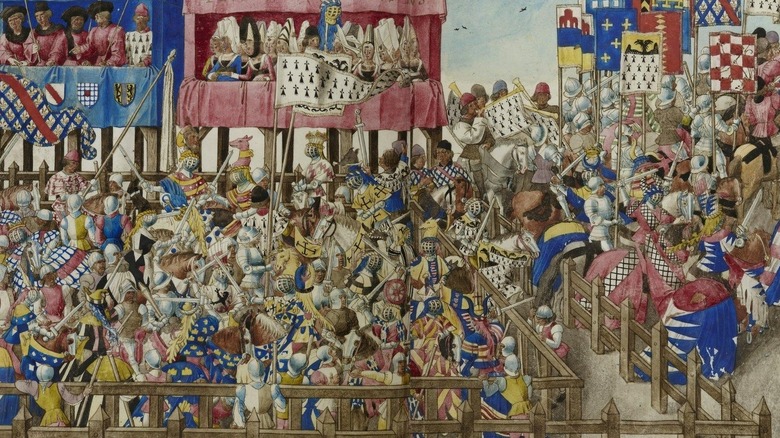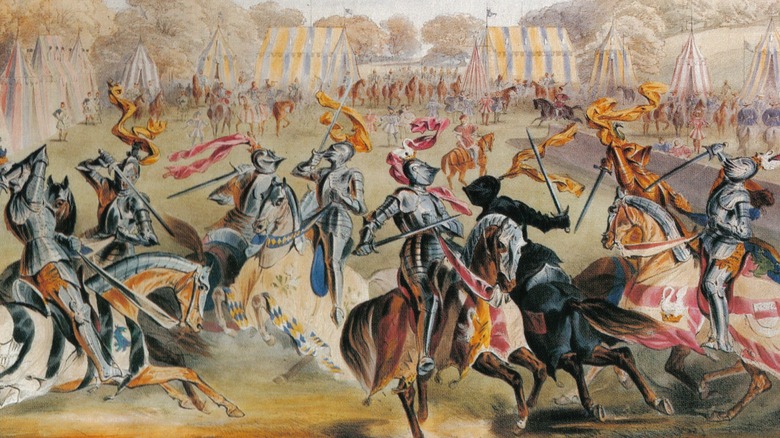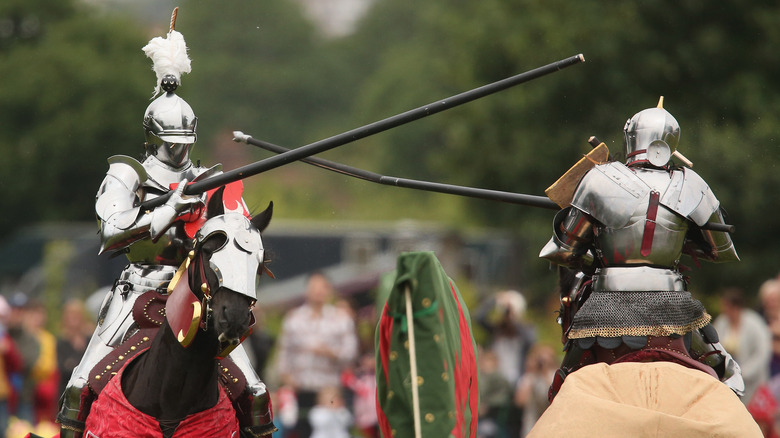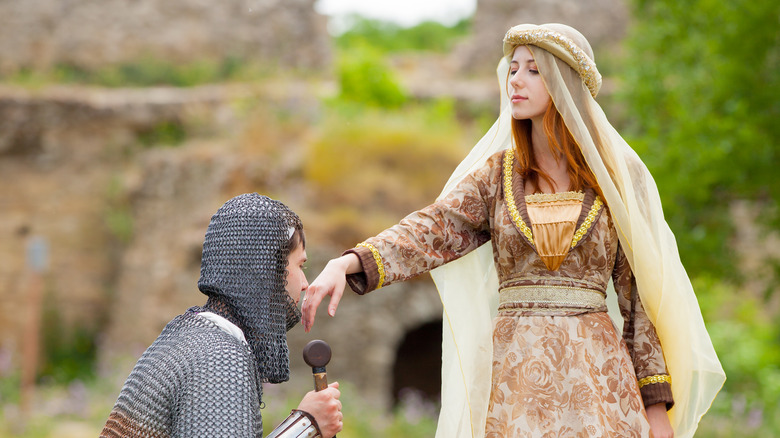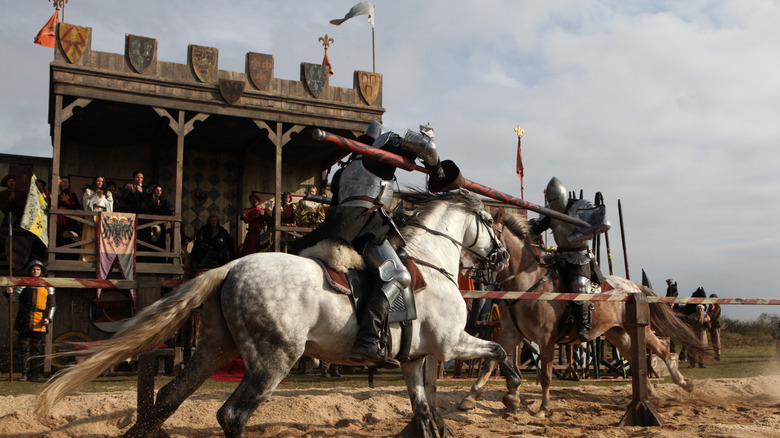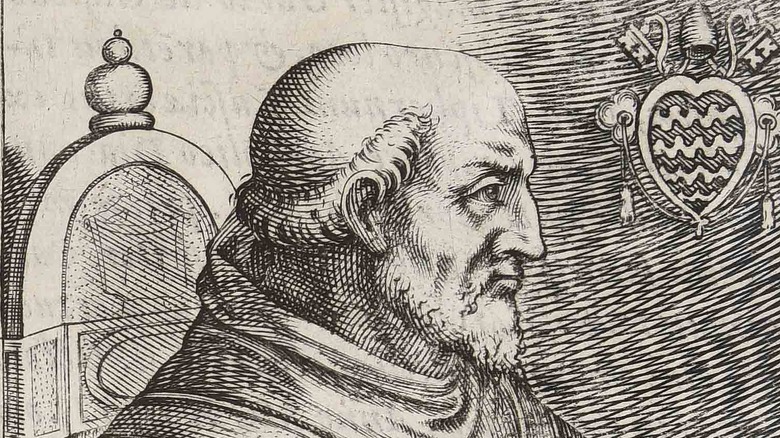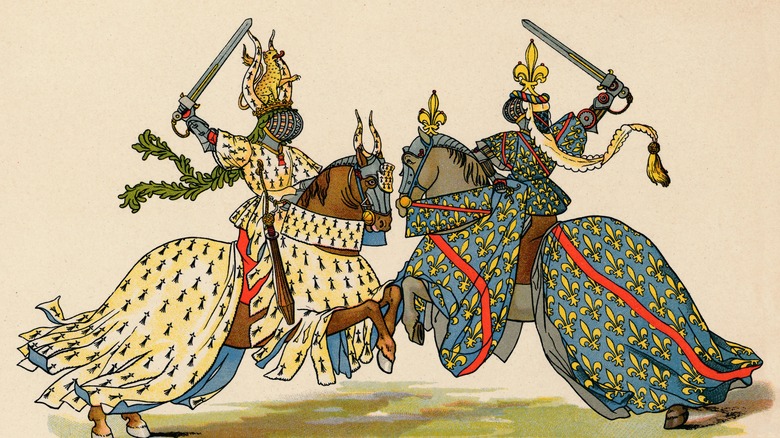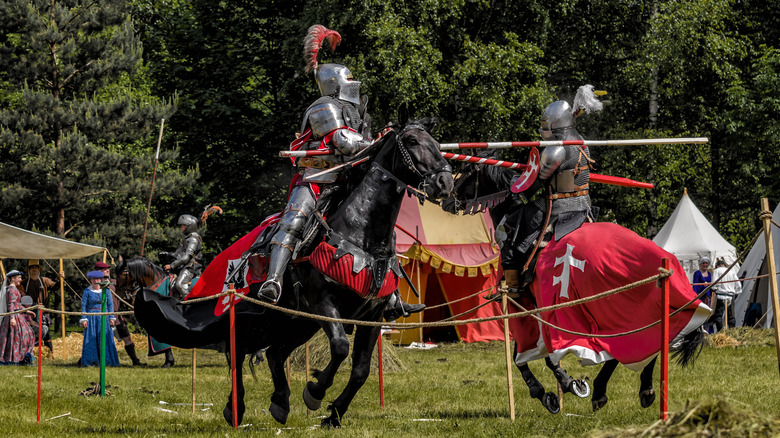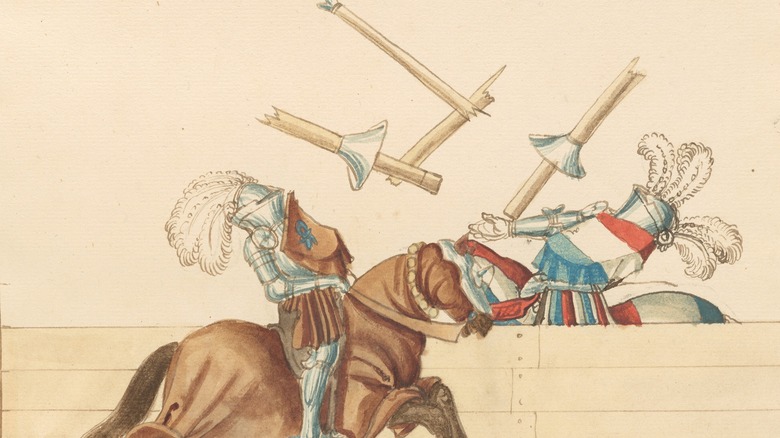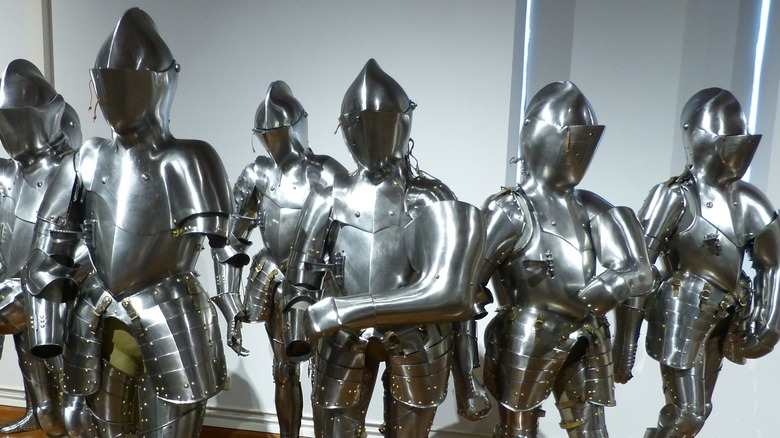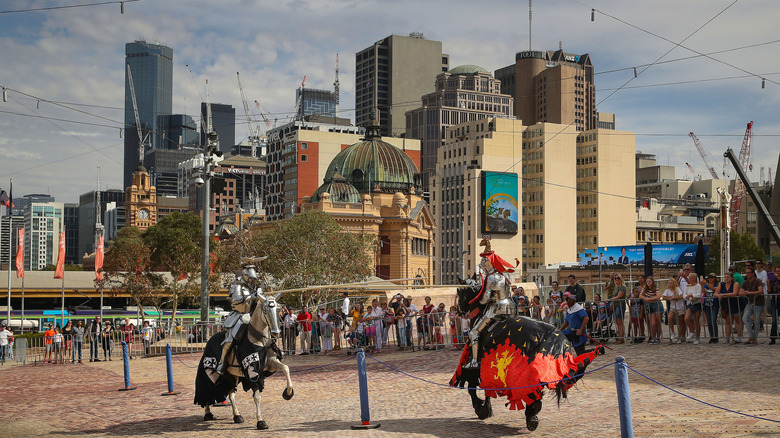The History Of Medieval Tournaments Explained
A classic image from Medieval Europe is the pageantry of jousting knights at a tournament. But according to the "Encyclopedia of Traditional British Rural Sports," popular knowledge of the medieval tournament and its pomp has been forged by media. The pageantry shown in the 1961 film "El Cid" and 2001's "Knight's Tale" show what everybody expects from a tournament of the Middle Ages.
The medieval tournament in its full form is usually envisioned as knights jousting in a sea of pageantry and chivalry. It calls up images of wooing princesses and derring do. It was a theatrical bloodsport. But is this really the case?
While there is some truth to this image of the tournament, the sport did not spring out of the codices of history fully formed. The medieval tournament evolved from an exercise of war and ransom to a sport of heraldry and chivalry. Let's take a deep dive and explain the history of medieval tournaments.
Tournaments started from a peace movement
The genesis of the medieval tournament was warfare. As explained by the World History Encyclopedia, as long as humans made war (i.e. as long as there have been humans), there has always been a need for warriors to practice how to fight.
As pointed out by "Tournament," the medieval tournament was developed in the north of France, a region marked by decentralized rule and plagued by feudal warfare after the disintegration of the Frankish Carolingian dynasty in the 9th century. Places like Picardy, Brabant, Flanders, and Hainault were scenes of chaotic and chronic violence. Another piece of evidence that links tournaments to this region is that this is where the earliest evidence of heraldry developed — something very closely tied to the tournament.
The irony is that tournaments, which were originally a war exercise, may have developed as part of a peace movement. They were seen as a way to avoid outright warfare but still allow Frankish warriors to keep their skills sharp. This is evident in the fact that many early tournaments were held in border zones, where no particular ruler held sway. Thus, even at a tournament, no sanction against state-on-state violence was broken. While the absolute date of the first tournament is unknown, it probably developed sometime before the year 1020. Britannica relates that some later French chronicles speculate the origin of the tournament to a 11th century French baron, Geoffroi de Preully.
Tournaments were originally battle royales on horseback
The Franks were renowned for their use of cavalry in war. This military strength led to the creation of the Carolingian Empire under Charlemagne. The most devastating tactic in the Frankish arsenal was the cavalry charge, which as described by "Fighting the Frankish Knights," was a massed charge of armored knights wielding long lances. It was a shock and awe weapon of great value, which later showed great value during the Crusades.
The Frankish military tradition prided itself on this mastery of heavy cavalry. The World History Encyclopedia reports that, tournaments, also called the tourney, hastilude, or tournoi, provided an excellent way outside of real warfare for knights to show off their skills.
The first tournaments were mass practice battles between groups of knights within an enclosed area of no particular size or shape. This was called the mêlée. The second part of the tournament was the joust, sometimes called tilting, in which two individual knights tried to unseat the other from his horse. Jousting eventually took precedence over the mêlée and became to be the central or even sole focus of tournaments.
Even though these were practice battles, in the early days of the tournament the knights used real weapons. As a result, there was always a real danger of serious injury or outright death.
Early tournaments were free for alls
While early tournaments were highly dangerous, they were also to some degree controlled. "Tournaments and Knightly Sports in Twelfth-and-Thirteenth-Century Occitania" explains that "the venue was fixed in advance, there were safety zones, there was sometimes a time limit on fighting, financial losses were also sometimes limited, there would be a truce at the end of each day when knights paid courtly visits to one another, and at the conclusion of the tournament it would be decided who had fought with the greatest distinctinction."
One of these early regulatory features were the "lists." The World History Encyclopedia explains how in the early tournaments, the lists were safety areas within the chosen battle ground where a knight could recuperate. "Tournament" describes how the lists were originally marked off by colored stakes. As time went on, the lists evolved to become enlarged structures and delineated grounds. Eventually, the lists would refer to the entire grounds of the tournament.
Early tournaments also featured marshals. They were there to enforce order. Still, since the playing areas were large it was hard to maintain any semblance of rules. As a result, death and injury were almost as common as in real battle.
The tournament was a means of upward mobility
There were several reasons why knights participated in tournaments. The World History Encyclopedia asserts that they were an opportunity for knights to display their nobility, heritage, and ability at arms. It was a forum to show just how skilled and chivalrous a knight was. Also, knights could audition for more prominent and well-paying positions. This was especially the case as the tournament evolved into an ostentatious form of pageantry.
While these reasons were important, "Tournaments and Knightly Sports in Twelfth-and-Thirteenth-Century Occitania" emphasizes that the tournament, especially in its early form, offered more down-to-earth economic incentives to participate. Booty and ransoms could be exchanged as the result of a mêlée. For example, a captured mount, armor, or even the knight himself could all be ransomed for profit. This was a great motivator for knights to participate and in iwas the primary reason for the tournament in the early days. This was critical to the knightly class. "A Short History of Tournaments" explains that in the 11th century, knighthood was not hereditary. Knights, or chevaliers were simply mounted warriors. This just meant that they were warriors who could afford horses and knew how to use them. The term "chivalry" originally just meant a group of horsemen. Yet, these horsemen became so vital to the military that their status rose throughout the period, helped in part by the tournament. They became quasi-aristocracy.
The tournament became more courtly
According to "A Short History of Tournaments," as the 12th century progressed, tournaments slowly changed. They became increasingly focused on chivalric values. Instead of rough-hewn warriors, "courtly" knights emerged. They, at least on the surface, embraced virtue. Tournaments became focused on the individual and his deeds of arms rather than the military skill of groups of armed knights. Jousting took precedence. Chivalry had been embraced as an ideal. "Fighting Techniques of the Medieval World," quotes John of Salisbury's 12th century summation of the purpose of a chivalrous knight: "to defend Church, to assail infidelity, to venerate the priesthood, to protect the poor from injuries, to pacify the province, to pour out their blood for their brothers... and if need be, to lay down their lives." A chivalrous knight was to honour women and women reciprocated by offering tokens to the gallant knights such as a sash or garter.
While these were selfless goals, the tournament offered an opportunity for knights to show off on how selfless they were. They also could earn prizes for winning. This trend hastened so that, as reported by the World History Encyclopedia, by the 14th century tournaments looked nothing like their predecessors from two centuries before. Heraldry and pageantry grew and the mêlée virtually disappeared. This is not to say they got less dangerous. At times, mêlées were still held and things could get ugly, especially when groups of knights of two different national origins competed.
Jousting became the centerpiece of a medieval tournament
Jousting entailed two knights charging at each other at full gallop with couched, wooden lances. Their intent was to strike the other with a lance. As detailed by "Fighting Techniques of the Medieval World," the jousters were separated by a barrier and were awarded points for touching their opponent's armor, shield, or helmet. In practice, knights were hardly ever unhorsed and sometimes extra points were awarded at the shattering of a lance — which was a delight to the crowd.
Some knights made a living from jousting. The knights William Marshal and Ulrich von Liechtenstein were particularly well known and had histories written of them. It should be noted that von Liechtenstein's history was written by himself.
Shining plate armor is a trope of the medieval tournament. Some have argued that the tournament also promoted the development of plate armor to supplant the use of chain mail. However, this is probably a historic myth since plate mail seems to have been developed after the height of the tournament. It is more likely that plate armor developed in response to changes in military tactics. Still, knights often wore specific plate armor for a tournament. The armor was also potentially dangerous since knights were liable to overheat in it. The World History Encyclopedia provides an example of how, in 1241, 80 German knights died of heat at a tournament in Germany.
The Church disapproved of tournaments for the obvious reasons
The Church disapproved of and condemned tournaments, particularly the mêlée. As "War and Combat" asserts, churchmen asserted that participants committed all seven deadly sins. According to "Battle," Pope Innocent II banned tournaments in 1130, writing in a papal bull: "We completely forbid those detestable fairs or festivals where knights customarily gather by agreement and heedless fight among themselves to make show of their strength and bravery, when often result men's deaths and souls' peril."
In fact, the pope outright denied Christian burials to any killed in a tournament. However, tournaments continued to grow in popularity despite the Church issuing repeated condemnations. Finally, in 1316, Pope John XXII gave up the fight and ended the ban. This might also be because the tournament itself had changed. "The Medieval Tournament: A functional sport for the upper class" argues that as the mêlée faded and the joust grew into more prominence, it became less about seizing ransom and mass violence, and more about chivalric values.
However, it should be stated that although tournaments became less dangerous they were still a form of violence. One well known death came after the end of the tournament's heyday. As reported by "Jousts, Tournaments, and War Training," King Henry II of France in 1559 was shot through the head with a long splinter from his opponent's lance while jousting. Apparently the piece of wood had found a way right through his helmet visor.
Lineage was extremely important in tournaments
Gradually, as the tournament evolved, fighting became displaced by pageantry and spectacle. By the 1300s, while there was still fighting, the danger had become mainly negated, according to the World History Encyclopedia. Knights used lighter and fancier armor. This armor had far more bling, including elaborate shields and helmets. "Medieval Heraldry" points out that much of this showy armor was certainly useless in battle. However, it was status symbol. One important symbol was the crest. Knights could earn crests at tournaments, and in certain regions they were a mark of distinction. The more elaborate the crest, the more chivalrous the knight.
Part and parcel to this, the knights showed off their lineage. Heralds cried out the heritage of a given knight at tournaments. Heraldry therefore assumed paramount importance. Coats of arms were displayed on shields and horse coverings. These banners were displayed proudly where the knight bivouacked. Rules were such that knights who were considered dishonorable might be banned from competition, and this may be that this is why some knights competed anonymously.
Rules of tournaments
There was no one rulebook for tournaments, and there were different sets of rules at any point in time. "The Medieval Tournament: A functional sport for the upper class" reports that the early mêlée tournaments were pretty much unregulated. You could enter when you wanted with as many knights as you could assemble. Most any tactic could be used, even that considered to be unsporting, such as holding back a reserve force until your opponents were exhausted. Several knights attacking a single knight was not uncommon.
As the tournament became courtly, it became restrained by the rules of chivalry and regulations were inserted. Brotherhood in arms was emphasized. These constraints allowed the tournament to become a spectacle which was tightly bound by rules which were generally accepted. One example of this, as reported in "A Short History of Tournaments," is the use of "stops" on a knight's armor, which held the lance so that the aim remained stable and thus safer. In general, competitors were still awarded points for touching an opponent's armor, shield, or helmet. "Jousting in Medieval and Renaissance Iberia" explains that at a tournament in Valladolid, Spain in 1434, the rules allowed for a knight to keep any piece of an opponent's harness that they broke off. It also stated that any knight who was unhorsed for any reason could not win the tournament nor could any knight who struck an opponent's horse.
Tournaments became very expensive
The pageantry of tournaments made the tournament an expensive proposition. "City and Spectacle in Medieval Europe" examined the question of how much a standard tournament cost by looking at one held in the city of Ghent in 1363. About 36% of the cost went toward materials and transportation, about 14% toward minstrels and guards, and the rest to "aristocratic displays."
What were these displays? This included gifts of wine to foreign VIPs (which was most of it), meals, and rentals. "The Medieval Tournament as Spectacle" quotes a 14th century French knight, Geoffrey de Charny, as writing that tournaments "combine great expenditure, cost of equipment and expense [with] bodily hardship, bruises, injuries, and sometimes risk of death."
By the time the tournament entered its last and most lavish phase it was, as the World History Encyclopedia asserts, too expensive for any but the richest knights to participate. To give an idea of the scale of costs, "Luxury Arts of the Renaissance" reports that in 1547, a collection of several suits of armor which included that for jousting, cost Ferdinand I of Tirol 1,258 florins plus gilding for an additional 463. Even though it is a set of several suits, the entire cost was about 12 times the wages of an upper-level civil servant. The author comments that this type of spending "has been likened to such modern day luxuries as yachts and executive jets."
Tournaments lost touch with reality
Medieval tournaments had become an elite sport without practical application. According to "A Short History of Tournaments," in the face of gunpowder tactics, the use of heavy armored cavalry became less of a military necessity. As a result, year by year there was a widening chasm between the tournament as a sport versus military application. The 16th and 17th centuries saw a precipitous decline in interest in the tournament. This was probably egged on by the 1559 death of Henry II. In its place, popular interest grew in individual combat fighting and archery.
However, as the World History Encyclopedia reports, tournaments never truly ceased. The sport was carried on into the 18th century and in the 19th century there were attempts to bring it back. Yet by this time, the symbolic meaning of knighthood and chivalry, and thus the tournament, had lost any meaningful practical application. This and its inherent danger made such attempts to revive it fizzle out. However, that is not to say that people don't keep on trying.
Tournaments are making a comeback?
Being a knight in shining armor is a dream of many people, and some are attempting, once again, to revive the medieval tournament — at least the jousting portion of it, not the mêlée. It is common to see jousting reenactments at Renaissance fairs and medieval festivals, but there are also others who are serious about making it an extreme, if not retro, sport. For example, in 2015, the BBC reported that an amateur jousting league called the Knights of Middle England had been operating since 2010. These modern day Lancelots engage in true jousts and are open to competitors of all sexes. And this isn't the only competition. According to the Medievalists, the largest modern jousting tournament is in Bavaria as part of an annual "knightly games" event. Other significant competitions are found in the United Kingdom and elsewhere.
As with centuries earlier, these modern tournaments follow similar rules, awarding points for touching an opponent's armor. The most points you can get is apparently five, for breaking your lance when striking the tip of an opponent's lance. Also, as it was centuries earlier, overheating in armor, punctured lungs, concussions, and dislocations are common injuries. Competitors report that the adrenaline rush is truly fulfilling. Will tournaments make a comeback? Maybe. There is even a push to get it into the Olympics.
